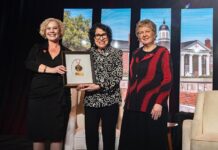LOUISVILLE, Ky. – University of Louisville researchers are one step closer to helping millions of people whose salivary glands no longer work because of disease or damage from treatment of diseases.
The scientific finding of Douglas Darling, PhD, professor, Department of Oral Health and Rehabilitation, UofL School of Dentistry, and his team identified a protein sorting mechanism used by the salivary gland. The National Institutes of Health supported study published on-line first this week in the Journal of Dental Research.
The scientific discovery could form the basis for advanced therapies for patients whose salivary glands are damaged or no longer function due to radiation therapy, prescription drugs or Sjogren’s Syndrome – an immune system disorder often defined by its two most common symptoms – dry eyes and a dry mouth.
The salivary glands are essential for lubrication, defense and beginning digestion in the mouth. The largest of the salivary glands – the parotid – secretes important proteins into the saliva. As with all salivary glands, it has multiple secretion pathways, therefore it must sort proteins destined for saliva into the correct pathway for secretion. This can be tricky as there are seven possible pathways. One pathway takes proteins to the salivary duct, other pathways carry different proteins to the ‘back’ side of the cell to be secreted into the blood or to form a supportive matrix for the cells. Transport along these pathways occurs by sorting the proteins into vesicles (hollow membrane sacs) that carry their “cargo” to the correct destination.
Conventional thought was that cargo proteins are moved into the forming vesicles by attaching to sorting receptor proteins. Darling and his team have discovered a completely new approach, suggesting the reason no salivary sorting receptor protein has been found is that it may not exist.
In Darling’s new model, the salivary cargo protein, Parotid Secretory Protein (PSP), selectively and directly binds to a rare lipid, a type of fat molecule called PtdIns(3,4)P2, present only in certain cell membranes – and only present on one side of the membrane. Darling also found PtdIns(3,4)P2 can flip to the inner part of the vesicle membrane – giving PSP the opportunity to bind it.
“These data imply that phosphatidylinositol-phosphate lipids like PtdIns(3,4)P2 may have multiple functions on the inner surface of organelles,” Darling said. “This is contrary to the current belief that their functions are always limited to one surface of the cell membrane.”
The next step is for Darling and his team to identify the molecular components used for flipping PtdIns(3,4)P2, and develop approaches to test ways to manipulate this potential protein sorting mechanism.
The study, Parotid Secretory Protein Binds Phosphatidylinositol (3,4) Bisphosphate can be found on the Journal of Dental Research website.


























